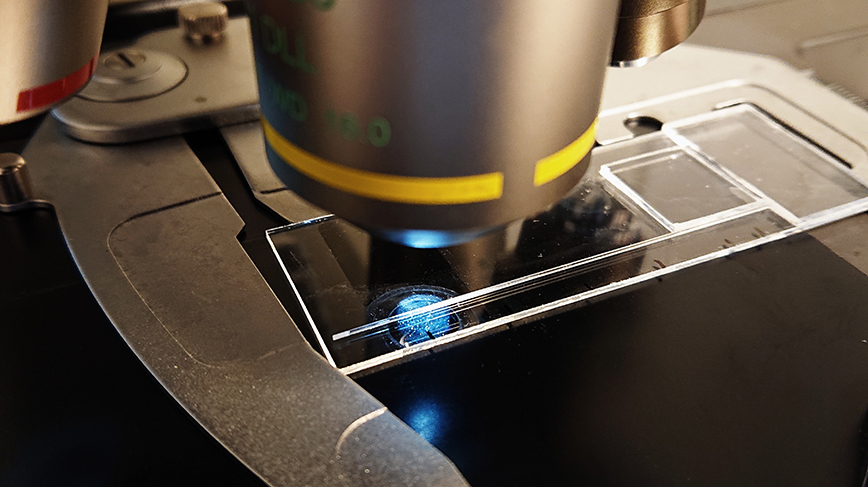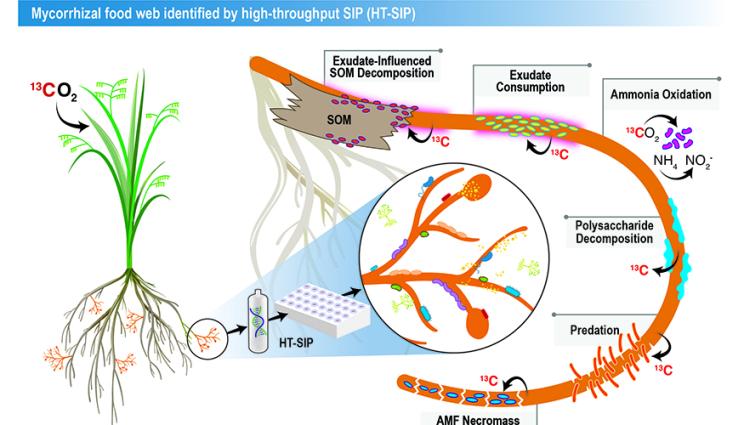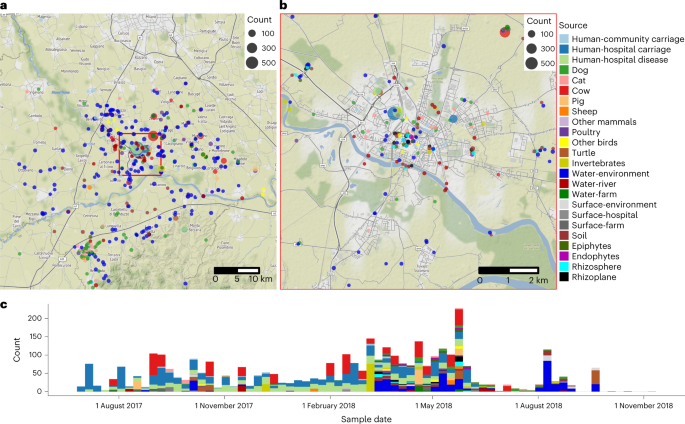2022-11-30 スウェーデン王国・王立工科大学(KTH)

The newly developed gel proved 98 percent effective in blocking sperm from entering the uterus of sheep. Pictured, a microscope is set up for examining the penetration of sperm through cervical mucus. (Photo: Xavier Druart, PIXAMIN platform, INRAE)
排卵期の雌の羊を使った実験では、このジェルは、無処置の対照動物に比べ、子宮の精子の数が平均98%減少した。これに対し、避妊薬の効果は91〜99%と認められている。
開発されたこの局所用ゲルを子宮に塗布したところ、8頭中1頭の雌の羊から2匹の精子が検出された。この結果は、望まない妊娠を防ぐための前例のないアプローチの可能性を示すもので、殺精子剤のように精子細胞を殺すのではなく、粘液を操作することによって精子をブロックするものである。
このメカニズムは、細菌が増殖する膣と子宮や生殖器上部とを隔離するバリアとしての子宮頸管粘液の自然な能力を利用するものであるとのことだ。また、頸管粘液は精子の動きも制御している。排卵までの間、粘液のバリアはより選択的なゲートキーパーとなり、子宮への精子の通過を例外的に認めている。
研究チームは、粘液に潤滑性を与えるタンパク質であるムチンの分子を、ハイドロゲルやメッシュ、縫合糸などの医療材料によく用いられる繊維状の天然物質であるキトサンで架橋し、この力学を変化させることに成功した。この組み合わせにより、子宮頸管粘液が一時的に厚くなり、精子が通り抜けにくくなる。
キトサンは、ヒトの子宮頸管粘液と精子を使った実験でも同様の効果があることが示された。キトサンは粘液のバリアを素早く強化し、1分後には精子の侵入を減少させ、5分後には完全に精子をブロックすることができた。
<関連情報>
- https://www.kth.se/en/om/nyheter/centrala-nyheter/non-hormonal-gel-proves-effective-at-helping-mucus-block-sperm-1.1210700
- https://www.science.org/doi/10.1126/scitranslmed.abm2417
精子に対する子宮頸管粘液バリアーの局所的強化 Topical reinforcement of the cervical mucus barrier to sperm
Ulrike Schimpf,Erika Caldas-Silveira,Ljudmila Katchan,Cécile Vigier-Carriere,Isabelle Lantier,Gilai Nachmann,Sebastian Gidlöf,Aino Fianu Jonasson,Lars Björndahl ,Stéphane Trombotto,Xavier Druart,Thomas Crouzier
Science Translational Medicine Published:30 Nov 2022
DOI: 10.1126/scitranslmed.abm2417
Capturing sperm with chitosans
Many women would prefer a nonhormonal, on-demand contraceptive that does not have the side effects of existing methods. Here, Schimpf and colleagues studied reinforcement of the cervical mucus barrier with chitosans as a potential contraceptive method. In vitro, chitosans passively diffused into human cervical mucus and decreased the ability of sperm to penetrate the mucus. The authors then developed a gel using a 36.2-kDa chitosan and applied it to ewes before artificial insemination, resulting in markedly reduced numbers of sperm in the distal cervix and uterus without irritating the vaginal epithelium. Although further studies showing contraceptive effect are needed, these findings suggest that chitosan gels might serve as an alternative to current hormonal and nonhormonal contraceptive methods.
Abstract
Close to half of the world’s pregnancies are still unplanned, reflecting a clear unmet need in contraception. Ideally, a contraceptive would provide the high efficacy of hormonal treatments, without systemic side effects. Here, we studied topical reinforcement of the cervical mucus by chitosan mucoadhesive polymers as a form of female contraceptive. Chitosans larger than 7 kDa effectively cross-linked human ovulatory cervical mucus to prevent sperm penetration in vitro. We then demonstrated in vivo using the ewe as a model that vaginal gels containing chitosan could stop ram sperm at the entrance of the cervical canal and prevent them from reaching the uterus, whereas the same gels without chitosan did not substantially limit sperm migration. Chitosan did not affect sperm motility in vitro or in vivo, suggesting reinforcement of the mucus physical barrier as the primary mechanism of action. The chitosan formulations did not damage or irritate the ewe vaginal epithelium, in contrast to nonoxynol-9 spermicide. The demonstration that cervical mucus can be reinforced topically to create an effective barrier to sperm may therefore form the technological basis for muco-cervical barrier contraceptives with the potential to become an alternative to hormonal contraceptives.


